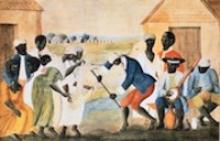*The Banjo’s African American Heritage is celebrated on this dates Registry. Since Caribbean Blacks created the banjo in the 17th century and carried it to North America in the 18th century, the banjo has been part of African American heritage. An African New World combination of European and African elements, early banjos resembled plucked full spike folk lutes like the akonting of Gambia, Senegal, and Guinea-Bissau and the bunchundo of Gambia and Guinea-Bissau. Like these instruments, early banjos had gourd or calabash bodies covered by a skin membrane and wood bridges held by string tension. Most early banjos had four gut or fiber strings, often three long and one short drone string, though some had two long strings and one short string. Banjos’ flat fingerboards and tuning pegs, not found on indigenous West African instruments, came from European instruments.
The Banjo's African American Heritage
First reported in Jamaica in 1687 and in Martinique in 1698, until the 19th century the banjo was identified exclusively with Black people. Banjos rang in Barbados, Antigua, St. Kitts, St. Croix, Suriname, and Haiti in the 1700s and early 1800s. First reported in North America in Manhattan in 1736, by the early 1800s, Black folk played banjos from New England to Louisiana. The Old Plantation, painted before 1790 by South Carolina planter John Rose, depicts a Black banjoist and a Black drummer playing for Black dancers. By the 1830s, white entertainers wearing black face makeup and singing what they called Black songs adopted the banjo. Known as “minstrels” by the 1840s, they became widely popular, touring the United States, Britain, Ireland, Australia, and New Zealand. Though they reflected American racism, their music and dance launched worldwide interest in Black music and the banjo.
By the 1840s five-string banjos with four long strings and one short string one short string, the highest in pitch, but set next to the lowest pitched long string, had developed. Wood frame rims to stretch the skin replaced the gourds. A commercial banjo industry appeared linking entertainers, sellers of banjo music, and manufacturers. By the late 19th century metal covered or replaced the wooden frame rims entirely, frets were added, metal strings replaced gut, and a variety of mechanisms were added to banjos to produce a loud, clear, treble sound. Black banjoists adopted these innovations to make even more powerful music. Black dances powered by banjo persisted into the twentieth century. Though Black banjoists, white show business banjoists, parlor banjoists, and white Southern folk banjoists exchanged tunes and techniques, the drive of Black banjoists to play for African American dancers preserved Black banjo’s distinctive West African musical approaches.
